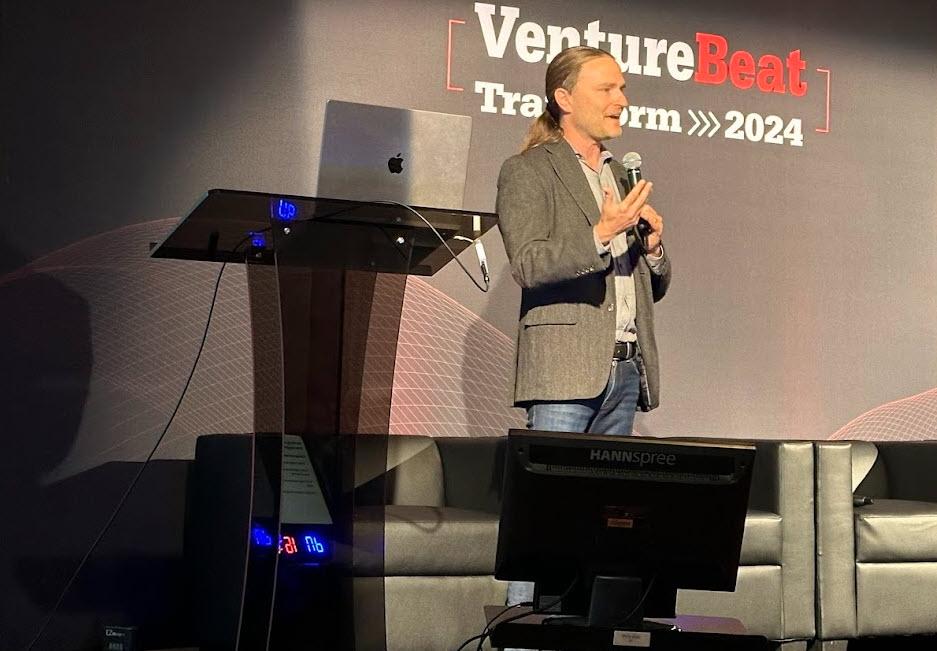
“Generative AI is not just a technological advancement; it is a revolution that empowers businesses to transform data into actionable insights, driving unprecedented innovation and efficiency,” Yaad Oren, managing director of SAP Labs U.S. and global head of SAP BTP Innovation, told the audience at his keynote during VB Transform 2024.
Oren’s keynote started with a strategic view of how SAP Labs is instrumental in integrating gen AI across the enterprise software giant’s broad software portfolio. Then, the conversation shifted to explaining the results SAP is delivering for Gibson, the iconic guitar manufacturer, and Team Liquid, a leading e-sports organization known for its competitive excellence and innovation in gaming.
SAP’s goal is to quickly scale AI across the enterprise
Oren emphasized that insights gained from one customer adopting AI are directly transferrable to another, accelerating scale and adoption in the process. Comparing the intricate landscapes in Team Liquid’s apps with the many challenges of improving supply chain performance and overcoming constraints, Otren explained that the enterprise implications of solving complex problems contribute to greater AL and machine learning (ML) model learning.
More than 24,000 SAP customers are currently using the company’s AI solutions. SAP has also integrated AI into more than 10,000 published and 5,000 scenario-based interfaces and messages through SAP Integration Advisor, further supporting their customers’ diverse enterprise requirements.
Founded in 1972, SAP’s enterprise resource planning (ERP) systems and their related applications are in use across a broad base of businesses globally. Their all-in shift to AI-based applications is delivering results for long-standing customers who began with their ERP systems.
Examples include SAP’s AI in Concur Invoice Management, automating the processing of 40 million invoices in 2022, saving customers a combined €440 million ($484 million at the current exchange rate). AI in SAP SuccessFactors provides personalized learning recommendations to an average of 4.2 million learners every month.
Oren’s keynote included an overview of the SAP AI framework, which centers on scaling embedded AI capabilities across an enterprise’s functional areas. One of the framework’s implicit goals is to provide a unified AI framework that scales finance, supply chain, HR, procurement, marketing and commerce, sales and services and IT. Joule, SAP’s copilot, provides access to embedded AI capabilities.

Four ways gen AI is improving SAP’s business
Taking the lessons learned from solving one customer’s challenges with gen AI and applying them at scale across multiple industries is inherent in how SAP Labs works. Oren’s examples and explanations underscore how important customer knowledge sharing is within the SAP innovation workflows.
Oren shared four ways genAI is improving business for SAP customers.
Enhancing game analysis for e-sports, capturing the lessons learned in other industries
SAP routinely analyzes more than 320 million data points to help Team Liquid optimize its strategies and performance in competitive gaming. Oren drew parallels from the game landscape to solving sourcing, supply chain and logistics challenges. That’s core to how SAP is attempting to scale gen AI across its diverse global customer base. Team Liquid relies on SAP’s real-time data platform to provide a holistic view of their applications. It combines multiple data sources and tools to create a siloed, decentralized data collection system. Team Liquid’s SAP platform stores 2.5 million hours of competition data in SAP HANA Cloud and more than 300 hours of match preparation working time saved in one year.
Optimizing marketing campaigns at scale
Oren explained that at Gibson, SAP’s automated campaign management tools analyze customer preferences and behaviors to create personalized marketing campaigns. Oren provided examples of how this approach helped Gibson increase engagement and revenue, with the company reporting a 50% increase in email revenue and a 10% increase in overall revenue within a year.
Improving supply chain and logistics performance
Oren emphasized how SAP is focused on aggregating and quickly learning from supply chain and logistics-related use cases across their customer base. Drawing on allegorical references from Team Liquid and others, Oren explained how supply chain, logistics and inventory challenges their customers face help gen AI models learn faster and deal with greater complexity — both essential goals to achieve in scaling models.
“In today’s fast-paced business environment, the ability to anticipate and mitigate supply chain issues is crucial,” said Oren. “Our AI solutions provide businesses with the insights they need to stay ahead.”
Enhancing customer engagement
Gibson is using gen AI-based apps and tools to gain real-time, data-driven insights to tailor its communication and marketing strategies to meet the unique preferences of its fans, from novice guitar players to professional musicians. With one of the most loyal customer bases in the music industry, Gibson uses gen AI to create a continual stream of new, interactive experiences for its loyal fanbase. Gen AI helps improve recommendations and keeps them informed of the latest news that’s most relevant to the music genres they follow, Oren explained.
Conclusion
Oren’s keynote blended the diverse nature of SAP’s evolving business, which started with EPR dominance and is now transitioning into an AI-centric future. Having the leader of SAP Labs present at VB Transform underscored how SAP sees its future being defined by AI first as it strives to migrate its large customer base forward from a long history of enterprise applications that made use of ERP data. Having learned the lessons from managing massive data sets across its customer base, SAP shows that it understands how AI needs to be accessible in its broad base application portfolio.
“The future belongs to those who can harness the power of data, and at SAP, we are committed to helping our customers achieve that future,” Oren concluded.
Author: Louis Columbus
Source: Venturebeat
Reviewed By: Editorial Team



